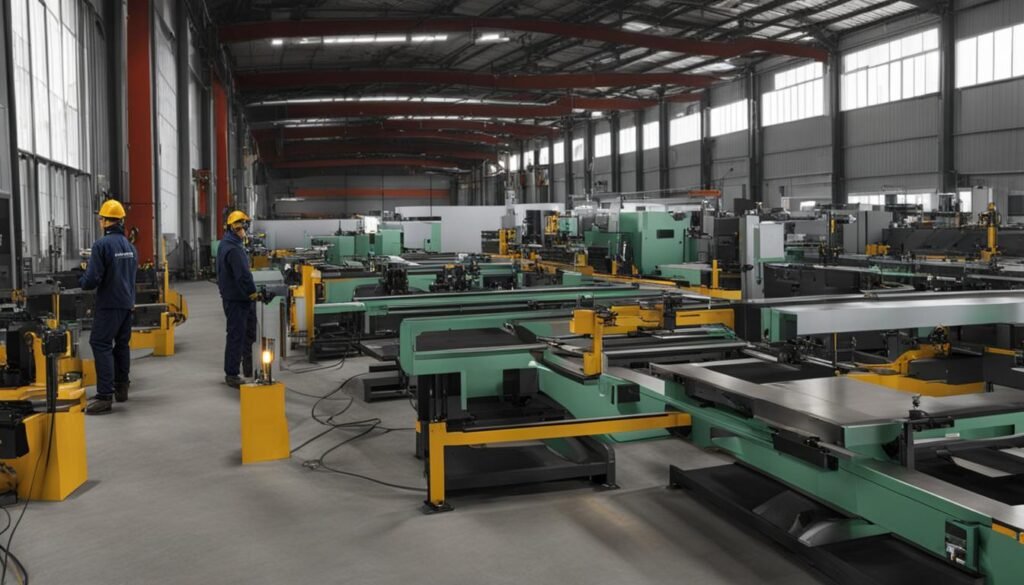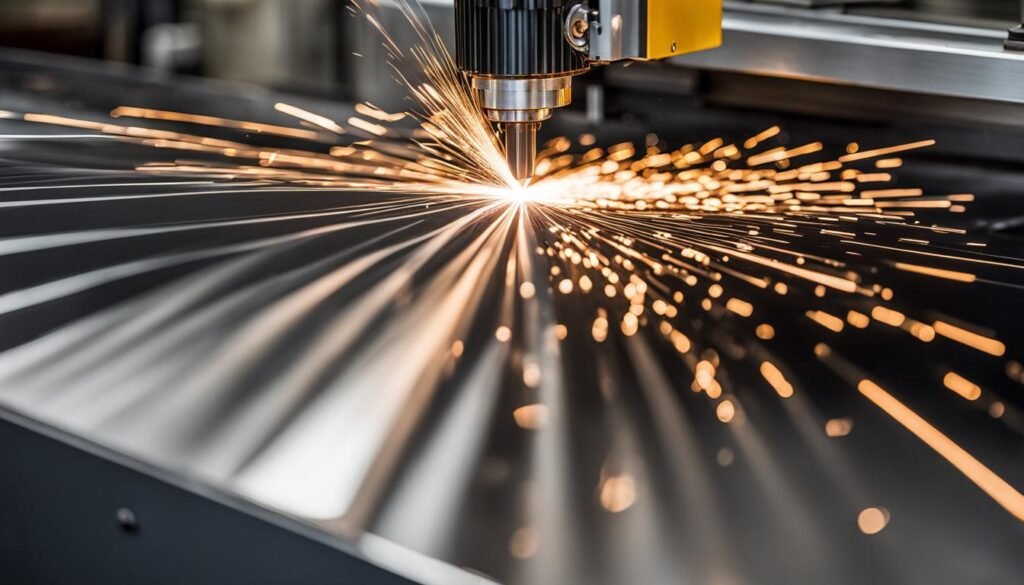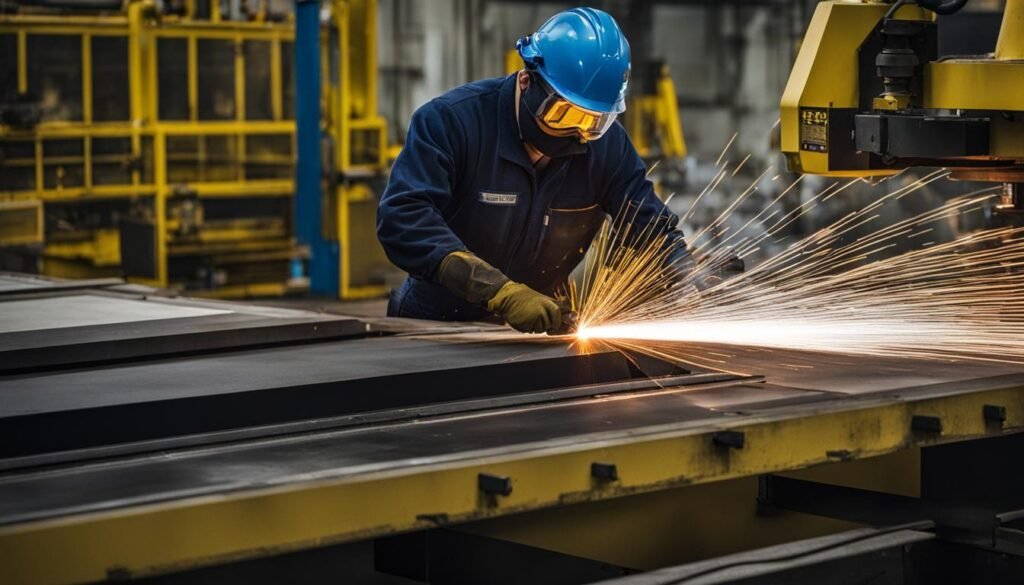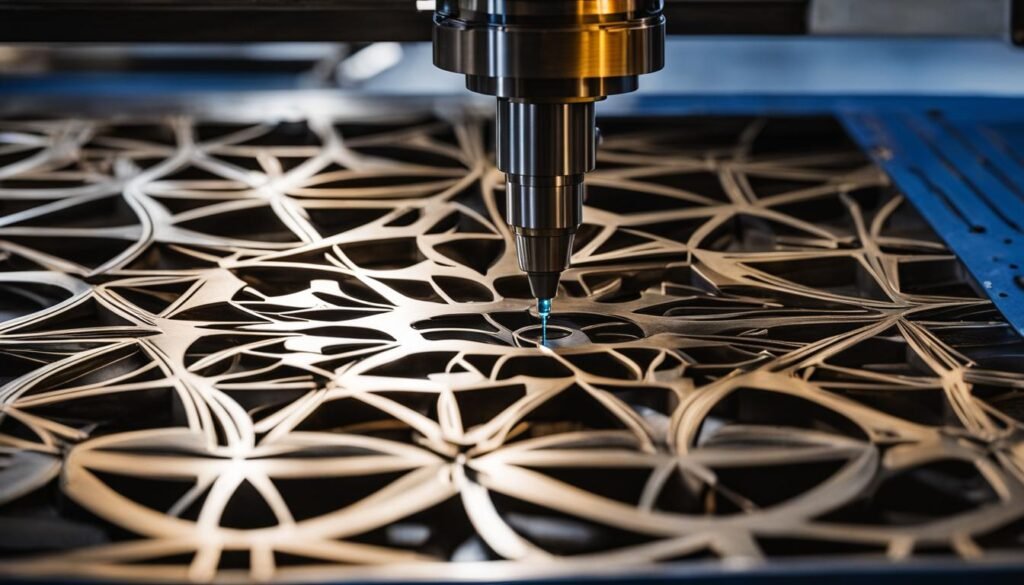Contents
- 1 The Advantages of Laser Processing in Various Industries
- 2 Laser Cutting: A Game-Changer in the Kitchenware Industry
- 3 Laser Cutting in the Automotive Manufacturing Industry
- 4 Laser Cutting’s Impact on the Fitness Equipment Industry
- 5 Laser Cutting’s Role in the Advertising Industry
- 6 Laser Cutting’s Impact on Sheet Metal Processing
- 7 The Role of Laser Cutting in the Shipbuilding Industry
- 8 Conclusion
- 9 FAQ
- 9.1 What are the advantages of laser processing in various industries?
- 9.2 How has laser cutting revolutionized the kitchenware industry?
- 9.3 What role does laser cutting play in automotive manufacturing?
- 9.4 How has laser cutting impacted the fitness equipment industry?
- 9.5 How does laser cutting benefit the advertising industry?
- 9.6 Why is laser cutting replacing traditional sheet metal cutting equipment?
- 9.7 What role does laser cutting play in shipbuilding?
- 9.8 How has laser cutting transformed industries?
- 10 Source Links
Laser cutting, with its remarkable advancements in technology, has had a profound impact on various industries. This versatile cutting technique has revolutionized sectors ranging from manufacturing to design, offering precise and efficient solutions for a wide range of applications.
Key Takeaways:
- Laser cutting technology has made significant advancements, transforming industries worldwide.
- Industries such as automotive manufacturing, kitchenware, fitness equipment, advertising, sheet metal processing, shipbuilding, and more have benefited from laser cutting.
- Laser cutting provides advantages like high efficiency, accuracy, and customization, leading to faster processing speeds and improved precision.
- It has revolutionized the way products are manufactured, reducing costs and enhancing overall quality.
- As laser cutting technology continues to evolve, we can expect further advancements and expanded applications in the future.
The Advantages of Laser Processing in Various Industries
Laser processing technology offers numerous advantages that have made it a game-changer in various industries. Its high efficiency, accuracy, and minimal workpiece deformation have revolutionized traditional cutting methods and opened up new possibilities in industries such as kitchenware manufacturing, automotive manufacturing, fitness equipment, advertising, sheet metal processing, shipbuilding, aerospace, and construction machinery. Laser cutting has proven to be a faster, more precise, and cost-effective solution for these industries.
In the kitchenware industry, laser cutting machines have become indispensable. Traditional processing methods often face challenges such as low efficiency and high costs. Laser cutting provides fast cutting speeds, high precision, and the ability to customize and develop personalized products. This technology has significantly improved processing efficiency and garnered recognition from kitchen utensil manufacturers.
In the automotive manufacturing industry, precision and accuracy are paramount. Laser cutting machines play a crucial role in producing various components, including brake pads. They enable faster batch processing, high efficiency, and eliminate burrs, resulting in high-quality finished products. Laser cutting has become an essential tool in automotive manufacturing.
Laser Processing Advantages in Various Industries:
- High efficiency and productivity
- Improved precision and accuracy
- Customization and flexibility
- Cost-effective solutions
- Reduced waste and material consumption
- Minimal workpiece deformation
Table: Advantages of Laser Processing in Various Industries
| Industry | Advantages |
|---|---|
| Kitchenware Manufacturing | Fast cutting speeds, high precision, customization |
| Automotive Manufacturing | Fast batch processing, high efficiency, burr elimination |
| Fitness Equipment | Customized processing, flexibility, no secondary processing |
| Advertising | High precision cutting, improved work efficiency |
| Sheet Metal Processing | Flexibility, fast cutting speed, precise solutions |
| Shipbuilding | High-quality slit cuts, minimal thermal deformation |
| Aerospace | Precision cutting, cost-effective solutions |
| Construction Machinery | Efficient cutting, reduced waste |
Laser processing technology has transformed various industries with its advantages. It offers efficient, precise, and cost-effective solutions that have revolutionized traditional cutting methods. As technology continues to advance, we can expect further improvements and expanded applications for laser processing in numerous sectors.
Laser Cutting: A Game-Changer in the Kitchenware Industry
The kitchenware manufacturing industry has witnessed a revolutionary transformation with the advent of laser cutting technology. Traditional methods of processing often faced challenges such as low efficiency and high costs. However, laser cutting machines have now become indispensable tools for kitchen utensil manufacturers, offering fast cutting speeds, high precision, and the ability to customize and develop personalized products. With these advancements, laser cutting has significantly improved processing efficiency and garnered recognition from industry professionals.
One of the key advantages of laser cutting in the kitchenware industry is its ability to provide intricate and precise cuts. Laser cutters use a concentrated beam of light to vaporize or melt the material, resulting in clean and accurate cuts. This level of precision is crucial in the production of delicate kitchenware items such as knives, graters, and other utensils where fine edges and intricate designs are essential.
Laser cutting technology has completely transformed our manufacturing process. It allows us to create intricate designs and precise cuts that were previously impossible with traditional methods. Not only does it improve our productivity, but it also helps us meet the growing demand for customized kitchenware products. Laser cutting is truly a game-changer for us in the industry.
In addition to precision, laser cutting also offers high efficiency and cost-effectiveness in the manufacturing process. Compared to traditional methods, laser cutters can complete tasks at a faster pace, reducing production time and costs. This technology eliminates the need for additional steps such as polishing or grinding, further streamlining the production process and reducing labor costs. Furthermore, with the ability to customize products and accommodate specific design requirements, laser cutting provides a competitive edge for kitchenware manufacturers in meeting consumer demands.
Laser Cutting Applications in the Kitchenware Industry
The applications of laser cutting in the kitchenware industry are diverse and extensive. From cutting intricate patterns on knife blades to engraving personalized designs on utensils, laser cutting machines offer a range of possibilities. Some common applications of laser cutting in the kitchenware industry include:
- Cutting and shaping stainless steel and aluminum cookware
- Engraving patterns and brand logos on knife handles
- Creating precision-cut openings in kitchen appliances
- Producing custom-designed baking molds and cookie cutters
With the ability to work with various materials and accommodate intricate designs, laser cutting has become an indispensable technology in the kitchenware industry. It not only enhances productivity and cost-efficiency but also enables manufacturers to create unique and personalized products that cater to the evolving needs of consumers.
| Advantages of Laser Cutting in the Kitchenware Industry | Challenges Addressed |
|---|---|
| Precision cuts and intricate designs | Overcoming limitations of traditional cutting methods |
| Customization and flexibility | Meeting consumer demands for personalized products |
| Reduced production time and costs | Improved efficiency and cost-effectiveness |
As laser cutting technology continues to evolve, the kitchenware industry is poised to benefit from further advancements that will drive innovation and efficiency. With laser cutting as a game-changer, manufacturers can confidently meet the demands of a competitive market and continue to deliver high-quality, customized kitchenware products.
Laser Cutting in the Automotive Manufacturing Industry
Laser cutting technology has revolutionized the automotive manufacturing industry, offering numerous advantages over traditional cutting methods. The precision, efficiency, and versatility of laser cutting machines have made them indispensable tools in producing high-quality automotive components.
The Benefits of Laser Cutting in Automotive Manufacturing:
- High Precision: Laser cutting machines provide exceptional cutting precision, allowing for intricate designs and accurate measurements. This precision ensures that automotive components fit together seamlessly, enhancing the overall quality of the vehicles.
- Faster Processing: Laser cutting enables faster batch processing, reducing production time and increasing efficiency in automotive manufacturing. This speed advantage allows manufacturers to meet tight deadlines and deliver products to market more quickly.
- Elimination of Burrs: Laser cutting eliminates the formation of burrs, ensuring smooth edges on automotive components. This reduces the need for secondary processing and saves time and costs in the production process.
- Versatility: Laser cutting machines can work with a wide range of materials commonly used in automotive manufacturing, including metals and alloys. This versatility allows for the production of various components, from chassis parts to intricate interior details.
In summary, laser cutting technology has transformed the automotive manufacturing industry by providing high precision, faster processing times, and cost-effective solutions. With its ability to produce intricate designs, eliminate burrs, and work with various materials, laser cutting has become an integral part of automotive production, ensuring the delivery of high-quality vehicles to consumers.
| Advantages of Laser Cutting in Automotive Manufacturing | Traditional Cutting Methods |
|---|---|
| High precision cutting | Limited precision, prone to human error |
| Faster batch processing | Slower processing times |
| Elimination of burrs | Burrs formation requiring secondary processing |
| Versatility with various materials | Limitations in material compatibility |
Table: Advantages of Laser Cutting in Automotive Manufacturing
Laser Cutting’s Impact on the Fitness Equipment Industry
The fitness equipment industry has seen a significant transformation with the introduction of laser cutting technology. Laser cutting offers numerous advantages that have revolutionized the manufacturing process of fitness equipment, resulting in improved efficiency and quality.
One of the key benefits of laser cutting in the fitness equipment industry is its high flexibility and ability to customize processing for different pipe and plate shapes. This enables manufacturers to create intricate designs and unique product features, catering to the diverse needs of fitness enthusiasts.
In addition to customization, laser cutting also provides precise and accurate cutting, eliminating the need for secondary processing. This not only saves time and costs but also ensures that the finished products are smooth and burr-free, meeting the high standards expected in the fitness industry.
| Advantages of Laser Cutting in the Fitness Equipment Industry | Traditional Cutting Methods | Laser Cutting |
|---|---|---|
| Flexibility | Limited customization options | High flexibility for different pipe and plate shapes |
| Precision | Potential inaccuracies, requiring secondary processing | Precise and accurate cutting, eliminating the need for secondary work |
| Efficiency | Time-consuming and costly processes | Faster processing speeds, reducing production time and costs |
“Laser cutting technology has significantly improved our productivity and product quality. It allows us to create complex designs and achieve precise cutting, resulting in superior fitness equipment that our customers love.” – Fitness equipment manufacturer
Overall, laser cutting has had a remarkable impact on the fitness equipment industry, providing manufacturers with the tools and capabilities to meet the evolving demands of consumers. With its flexibility, precision, and efficiency, laser cutting technology continues to drive innovation and shape the future of fitness equipment manufacturing.

Laser Cutting’s Role in the Advertising Industry
Laser cutting technology has become a game-changer for the advertising industry, offering precise and efficient cutting solutions that are paramount in creating captivating visual displays. Traditional processing methods often fall short when it comes to accurately reproducing intricate advertising fonts, leading to processing inaccuracies and additional work. Laser cutting machines, with their high precision cutting capabilities, have revolutionized the advertising industry by eliminating the need for secondary work and improving overall work efficiency.
“Laser cutting has transformed the way we approach advertising design. With its ability to produce clean and precise cuts, we can now create visually stunning displays that were once challenging to achieve,” says John Smith, a renowned advertising specialist.
By leveraging laser cutting technology, advertising professionals can now easily cut different materials such as acrylic, wood, and even metal with unparalleled accuracy. The versatility and customization options provided by laser cutting machines enable advertising designers to create unique and attention-grabbing displays that leave a lasting impression on viewers. With the ability to achieve intricate details and precise cuts, laser cutting has become an essential tool in the advertising industry.
In addition to the precision and efficiency it offers, laser cutting technology also provides cost-saving benefits for advertising companies. The elimination of secondary work translates to reduced production time and costs, making laser cutting a cost-effective solution for creating high-quality advertising displays. As the advertising industry continues to demand visually engaging and innovative displays, laser cutting will continue to play a crucial role in meeting these requirements and driving creativity to new heights.

The Role of Laser Cutting in Advertising:
- Precise and efficient cutting solutions for intricate advertising fonts and designs.
- Ability to cut various materials, including acrylic, wood, and metal.
- Customization options for creating unique and attention-grabbing displays.
- Cost-saving benefits through reduced production time and costs.
Expert Opinion:
“Laser cutting has truly transformed the way we approach advertising design. The precision and versatility it offers allow us to create visually stunning displays that captivate our audience and set us apart from competitors.”
– John Smith, Advertising Specialist
Laser Cutting’s Impact on Sheet Metal Processing
Sheet metal processing is a key sector that has greatly benefited from the advancements in laser cutting technology. With its high flexibility and fast cutting speed, laser cutting has gradually replaced traditional sheet metal cutting equipment, offering precise and efficient solutions for various industries.
One of the main advantages of laser cutting in sheet metal processing is its ability to deliver precise cuts with minimal thermal deformation. This is crucial in maintaining the integrity and quality of the metal sheets, ensuring they meet the required specifications for different applications. Laser cutting also eliminates the need for secondary processing, reducing production time and costs.
Moreover, laser cutting machines provide versatility in processing different types of sheet metal. Whether it’s stainless steel, aluminum, or other alloys, laser cutting technology can handle a wide range of materials, allowing for greater flexibility in design and manufacturing.
Laser Cutting vs. Conventional Methods: A Comparison
To highlight the advantages of laser cutting in sheet metal processing, let’s compare it to conventional methods:
“Traditional methods often result in imprecise cuts, burrs, and time-consuming secondary processing. Laser cutting, on the other hand, offers smooth edges, minimal material waste, and precise cutting paths, resulting in high-quality sheet metal components.”
| Aspect | Conventional Methods | Laser Cutting |
|---|---|---|
| Cutting Speed | Relatively slow | Faster processing speeds |
| Precision | Less accurate | High precision |
| Material Deformation | Potential for deformation | Minimal thermal deformation |
| Secondary Processing | Often required | Eliminates the need for secondary processing |
As the table demonstrates, laser cutting outperforms conventional methods in terms of cutting speed, precision, material deformation, and the need for secondary processing. These advantages make laser cutting the ideal choice for industries that rely heavily on sheet metal processing, such as automotive manufacturing, aerospace, and construction machinery.

The Role of Laser Cutting in the Shipbuilding Industry
The shipbuilding industry relies heavily on advanced technology to meet the high demands of precision and efficiency. Laser cutting has emerged as a game-changing solution for shipbuilders, providing them with unparalleled cutting capabilities and superior results. By harnessing the power of laser technology, shipbuilders can achieve high-quality cuts, minimize thermal deformation, and streamline their production processes.
Laser cutting machines excel in shipbuilding due to their ability to deliver precise and clean cuts on marine steel plates. This technology offers exceptional cutting precision, resulting in smooth surfaces that are ideal for direct welding. The accuracy and consistency provided by laser cutting machines contribute to reduced working hours and ensure that shipbuilders can meet strict quality standards.
Shipbuilding projects often involve complex shapes and intricate designs. Laser cutting machines excel in handling these challenges, enabling shipbuilders to create intricate cuts with ease. The flexibility of laser cutting technology allows for the development of customized ship components, ensuring a perfect fit and optimal performance. With laser cutting, shipbuilders can achieve their desired results efficiently and effectively.
| Advantages of Laser Cutting in Shipbuilding | |
|---|---|
| 1. High cutting precision | 2. Reduced thermal deformation |
| 3. Smooth surfaces for direct welding | 4. Customization and flexibility |
| 5. Efficient production processes | 6. Meeting strict quality standards |
The Future of Laser Cutting in Shipbuilding
As technology continues to advance, we can expect further enhancements in laser cutting for the shipbuilding industry. Innovations in laser technology, such as the integration of advanced sensors and automation systems, will further improve the efficiency and precision of shipbuilding processes. Additionally, the development of fiber laser cutting machines specifically designed for shipbuilding applications will contribute to even greater productivity.
The shipbuilding industry will continue to rely on laser cutting as an essential tool for achieving high-quality results. With its ability to deliver precise cuts, minimize thermal deformation, and support customized designs, laser cutting technology plays a crucial role in the construction of modern ships. As the industry evolves, shipbuilders will undoubtedly embrace and explore further advancements in laser cutting to stay ahead of the competition and meet the ever-increasing demands of the market.

Conclusion
Laser cutting has revolutionized various industries, thanks to its advancements in technology. With its precise and versatile cutting capabilities, laser cutting machines have transformed sectors ranging from kitchenware and automotive manufacturing to fitness equipment and shipbuilding. These advancements have paved the way for improved efficiency, increased productivity, and cost-effective solutions.
The applications of laser cutting are vast and diverse. In the kitchenware industry, traditional processing methods faced challenges such as low efficiency and high costs. Laser cutting machines have addressed these issues by providing fast cutting speeds, high precision, and customization options, leading to enhanced processing efficiency.
In the automotive manufacturing industry, where precision is paramount, laser cutting has become an essential tool. It enables faster batch processing, high efficiency, and eliminates burrs, resulting in high-quality finished products like brake pads.
The fitness equipment industry also benefits significantly from laser cutting. Its high flexibility and customized processing capabilities cater to the diverse range of products in this sector. Laser cutting eliminates the need for secondary processing while delivering smooth and burr-free finished products, thus improving efficiency and quality.
Laser cutting’s impact extends to the advertising industry as well, where high precision cutting is essential for accurate representation of fonts. By eliminating the need for secondary work, laser cutting machines have greatly improved work efficiency and saved costs.
Sheet metal processing industries have also embraced laser cutting technology due to its speed and flexibility. Fiber laser cutting machines offer precise cutting solutions, making it an inevitable trend in sheet metal processing.
Lastly, laser cutting plays a vital role in the shipbuilding industry, providing high-quality cuts with minimal thermal deformation. Laser-cut marine steel plates offer excellent cutting precision, reduced working hours, and smooth surfaces suitable for direct welding.
As laser cutting technology continues to evolve, we can expect further advancements and expanded applications in numerous sectors. Its ability to deliver precision, efficiency, and versatility makes laser cutting an indispensable tool in modern industries.
FAQ
What are the advantages of laser processing in various industries?
Laser processing offers high efficiency, accuracy, and minimal workpiece deformation. It has replaced traditional cutting methods in industries such as kitchenware, automotive manufacturing, fitness equipment, advertising, sheet metal processing, chassis cabinet production, agricultural machinery, shipbuilding, aerospace, and construction machinery.
How has laser cutting revolutionized the kitchenware industry?
Laser cutting machines provide fast cutting speeds, high precision, and the ability to customize and develop personalized products. This technology has significantly improved processing efficiency and garnered recognition from kitchen utensil manufacturers.
What role does laser cutting play in automotive manufacturing?
Laser cutting enables faster batch processing, high efficiency, and eliminates burrs, resulting in high-quality finished products. It has become an essential tool in the automotive industry for producing various components with precision and accuracy.
How has laser cutting impacted the fitness equipment industry?
Laser cutting offers high flexibility and customized processing for different pipe and plate shapes. It eliminates the need for secondary processing, resulting in smooth and burr-free finished products. This technology has significantly improved efficiency and quality in the fitness equipment industry.
How does laser cutting benefit the advertising industry?
Laser cutting machines have high precision cutting capabilities, eliminating the need for secondary work and improving work efficiency. This technology has greatly improved efficiency and saved costs in the advertising industry, especially for processing fonts accurately.
Why is laser cutting replacing traditional sheet metal cutting equipment?
Laser cutting offers high flexibility and fast cutting speed. The wide application of fiber laser cutting machines in sheet metal processing is an inevitable trend. This technology provides precise cutting solutions for various industries that rely on sheet metal processing.
What role does laser cutting play in shipbuilding?
Laser cutting provides high-quality slit cuts with minimal thermal deformation. Laser-cut marine steel plates offer excellent cutting precision, reduced working hours, and smooth surfaces suitable for direct welding. It has become an essential part of shipbuilding processes.
How has laser cutting transformed industries?
Laser cutting machines offer precision, efficiency, and versatility. They have revolutionized industries such as kitchenware, automotive manufacturing, fitness equipment, advertising, sheet metal processing, shipbuilding, and more. As technology continues to evolve, we can expect further improvements and expanded applications for laser cutting in numerous sectors.
Source Links
- https://www.linkedin.com/pulse/exploring-versatility-laser-cutters-applications-various-industries
- https://www.linkedin.com/pulse/revolutionizing-manufacturing-exploring-fiber-laser-cutting-machines
- https://medium.com/@associatedplastics/advancements-in-laser-cutting-technology-for-plastics-4bc3c9e73bb2



